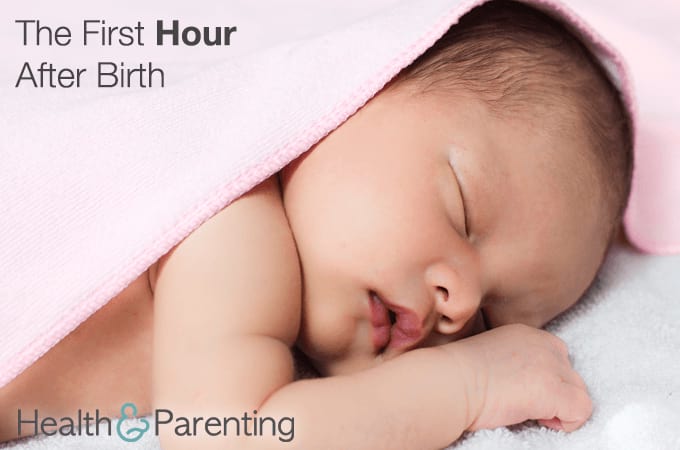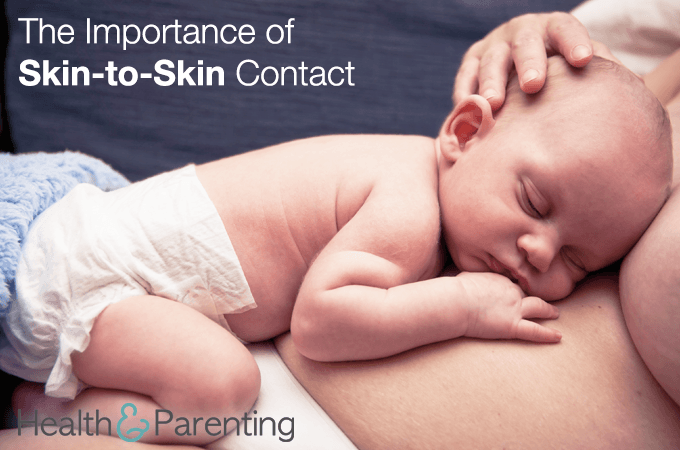For 9 months, your baby is kept at a toasty temperature, comfortably protected all around by amniotic fluid, hearing your voice and the metronome of your heartbeat. At birth, this all changes and your baby needs to quickly adapt to the outside world: from weightlessness to gravity, from the warmth of your body temperature to the cooler room temperature, from the constant contact with you to the openness of the world.
One of the most important plans you can make for your birth is arranging to spend the first hour or so after birth skin-to-skin with your newborn. Research shows that babies kept skin-to-skin have a steadier heart rate and temperature, better respiration, normal blood sugar levels, and less crying.
Experts have also found that newborns display a distinct progression of behaviors in the first hour after birth that facilitate adaptation to the outside world, as well as initiation of breastfeeding.
According to Widström and colleagues, here are the 9 stages you can expect when a baby is placed skin-to-skin with mom after birth:
1. The Birth Cry occurs immediately after birth, as your baby’s lungs expand.
2. Relaxation comes quickly in a baby skin-to-skin with mom as the baby reorients. This is a brief period of no mouth or hand movements from baby.
3. Awakening occurs about 3 minutes after birth, when baby will begin to thrust head and shoulder, open his eyes and start making small mouth movements.
4. More Activity starts about 8 minutes after birth with an increase in mouth and suckling movements, including a more pronounced rooting reflex. Baby’s eyes will be open; he will be searching visually and may look at the breast. You may notice him moving his mouth from side to side on mom’s skin, rubbing his cheek against mom, salivating, and sticking his tongue out. He may move his hand to his mouth and even to mom’s breast and back to his mouth. He may massage the breast with both hands, and may lift part of his body off of mom in an effort to get closer to the breast.
5. Periods of Rest typically follow periods of activity throughout the first hour.
6. Crawling motions start about 35 minutes after birth. Baby may use his legs and arms to propel himself toward the breast – this might include leaping, sliding, or crawling.
7. About 45 minutes after birth, a stage of Familiarization starts where baby might lick the nipple, touch or massage the breast, look at mom, or move his hands from mouth to breast and back. This stage might last for as long as 20 minutes.
8. About an hour after birth, the baby begins Suckling – self attaches and suckles at the breast.
9. Finally, baby starts recovery with a period of Sleep. This may start 1 ½ to 2 hours after birth.
Babies will complete these stages at their own individual pace, and shouldn’t be forced or rushed. Mom may need to provide some support so baby doesn’t flop off of her body, and she can guide the breast when baby is ready to begin suckling. If you have used pain medications during labor, it may take your baby longer to complete the stages and start to suckle. If you have had a cesarean birth, this first hour skin-to-skin is still possible, but may take more preparation before the birth to get everyone onboard and a plan in place.
If the facility where you plan to give birth does not routinely practice skin-to-skin at birth, you may need to make arrangements ahead of time. Your time skin-to-skin will work best if:
- Baby is placed belly-down, directly on your chest or abdomen, right after he is born.
- Baby is dried while skin-to-skin. Both of you can then be covered with a blanket, if necessary.
- Baby’s hands are not b wiped, and your breasts are not washed or wiped before feeding.
- Newborn assessments (such as APGAR scoring) are completed with the baby skin-to-skin with mom.
- Complete interventions (such as suctioning) while baby is skin to-skin or can be delayed until after the first breastfeeding has taken place, barring any emergency situations.
- Raise the head to the bed or giving mom extra pillows may help with visual contact between mom and baby and with supporting her as baby begins to move.
- You continue skin-to-skin contact until the first breastfeeding has taken place.
Have you planned for spending time skin-to-skin with your baby?
Written by Michelle, childbirth instructor, lactation consultant, and mother to 4 busy kids
This information is not intended to replace the advice of a trained medical doctor. Health & Parenting Ltd disclaims any liability for the decisions you make based on this information, which is provided to you on a general information basis only and not as a substitute for personalized medical advice. All contents copyright © Health & Parenting Ltd 2017. All rights reserved.











